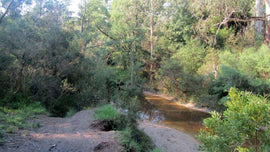In South-East Queensland at a property on Yuggera Country, Greenfleet is restoring over 50 hectares of native ecosystem to extend habitat for the local koalas and deliver climate action. The namesake, Cherry Gully, refers to the Brush Cherry (Syzygium australe) that can be found on the property.
This project will provide extensive wildlife habitat along the Cherry Gully riparian corridor and improve water quality by restoring land in areas along Cherry Gully and Ivory Creek for the Brisbane River Catchment.
Location & Overview

Located north-west of Brisbane near Toogoolawah, the property at Cherry Gully runs west from the junction of Ivory Creek and Oaky Creek and extends either side of Oaky Creek into hilly terrain in other parts of the property. The different terrain across the site means there are multiple ecosystems being restored through this project.
This is part of a series of projects in this area, where Greenfleet will be restoring over 250 hectares between 2022 and 2024 around Ivory creek.
This site was a partly cleared former beef cattle grazing and cattle feed lot property. As an ex-grazing property, Cherry Gully contained various pasture species and non-natives, but no invasive pasture. Unusually, the site did contain some established native grasses, which Greenfleet has been able to incorporate into our establishment of biodiverse native ecosystem.
You can see more of Greenfleet’s revegetation projects on our interactive map here.
Revegetation & Species Selection
There are multiple Regional Ecosystems found in this area and the unique terrain across Cherry Gully means there are several different forest types on this property alone. The site ecology included various ecosystems of concern, including Fringing Riverine Wetland and various woodlands, as well as endangered Floodplain. To create a biodiverse forest that complements these ecosystems, 18 species were selected as a part of this revegetation project.
Prior to planting, the soil was ripped in preparation for the native seedlings to be planted. This process reduces soil compaction and helps water infiltration when it rains. In this photo, you can see the lines ripped through the site.
Fast-growing eucalypt species were planted to form the forest canopy, including Gum-topped Box (Eucalyptus moluccana), which grows up to 30 meters in height and is a preferred source of habitat and food for koalas and native bats. Other species planted include Brush Box (Lophostemon confertus), a fast-growing pioneer species, and Broad-leaved Apple (Angophora subvelutina), which attracts birds, bees, and Grey-headed Flying Foxes.

Wildlife Habitat Restoration
By restoring native forest, habitat is being extended for known koala populations utilising the current remnant vegetation on the property. Tree species such as Blue Gum (Eucalyptus tereticornis) is an important source of food and provides habitat to these animals.
The reforestation of Cherry Gully will also provide habitat for native bats, which are heavily impacted by land clearing and temperature increases. In particular, this forest will provide potential habitat for Grey-headed Flying Foxes. These creatures, which are listed as vulnerable, are one of the largest bats in Australia, with a wingspan reaching over 1 meter.
Grey-headed Flying Fox populations have been declining due to land clearing and habitat loss. They feed on nectar and pollen from native trees, especially eucalypts, and may travel 50 kilometres for food. These flying foxes play an important role in the health of forest ecosystems because the pollinate and disperse seeds.
The variety of species planted will provide more food for the bats as they move across this region. When the forest is more established, tree hollows will develop and provide nesting locations for other native birds and animals.

Climate Action
By restoring ecosystems, Greenfleet delivers climate action by establishing native forests that remove carbon as they grow.
Greenfleet uses the Full Carbon Accounting Model (FullCAM) to measure the carbon uptake of our forests. Over its lifetime, the legally protected native forest at Cherry Gully will remove nearly 16,240 tonnes of carbon from the atmosphere. The equivalent of what 3,775 average vehicles emit in a single year.
About Greenfleet
Greenfleet is a 25-year-old Australian not-for-profit environmental organisation protecting our climate by restoring our forests.
We plant native biodiverse forests to capture carbon emissions and help fight the impacts of climate change. Greenfleet is Australia’s first carbon offset provider and since 1997 has planted over 11.2 million native trees creating more than 550 forests in Australia and New Zealand.
Our forests are legally protected for up to 100 years, conserving biodiversity, improving the health of our soils and waterways, and restoring habitat for wildlife, including many endangered species.
Greenfleet grows forests and climate hope by empowering people to take tangible and long-lasting environmental action.
Find out more about Greenfleet and how to get involved here.
Location size
Planting dates
Species
- Acacia disparrima
- Acacia maidenii
- Acacia melanoxylon
- Alphitonia excelsa
- Angophora subvelutina
- Brachychiton populneus
- Casuarina cunninghamiana
- Corymbia intermedia
- Corymbia tessellaris
- Eucalyptus crebra
- Eucalyptus melanophloia
- Eucalyptus moluccana
- Eucalyptus propinqua
- Eucalyptus sideroxylon
- Eucalyptus tereticornis
- Lophostemon confertus
- Melaleuca bracteata
- Melaleuca viminalis




